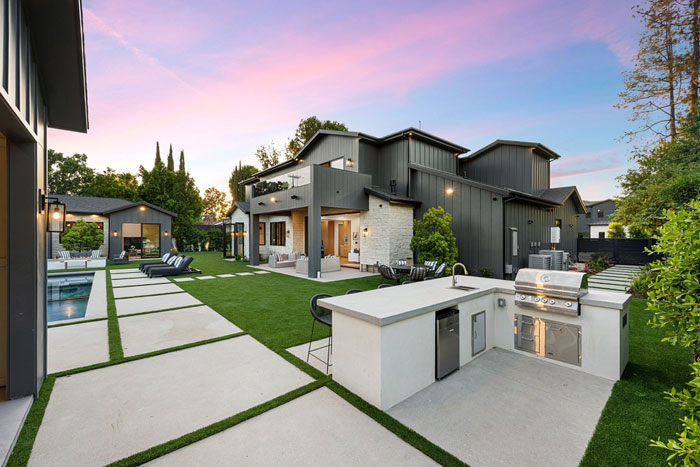Your home is more than shelter. It’s where you recharge, create, connect, and find peace in an increasingly complex world.
At Clifford Built, we understand that true luxury isn’t just about beautiful finishes and impressive spaces but about creating environments that enhance your wellbeing and support your best life.
Let’s explore how thoughtful design psychology can transform your Gold Coast home into a sanctuary that nurtures both body and mind.
How Design Affects Wellbeing
Our brains are constantly processing our environment, and the spaces we inhabit have a profound impact on our mood, energy levels, and overall wellbeing.
Research in environmental psychology has revealed fascinating connections between our physical surroundings and our mental state.
Natural light exposure helps regulate our circadian rhythms, improving sleep quality and energy levels.
Ceiling height can influence how we think and feel, with higher ceilings promoting creativity and expansive thinking. Even the materials we touch and see daily can affect our stress levels and sense of comfort.
Understanding these connections allows us to design homes that don’t just look beautiful but actively contribute to your health and happiness.
Bringing Nature Inside
The Gold Coast’s stunning natural environment provides the perfect inspiration for biophilic design principles that connect us with nature even when we’re indoors.
This connection isn’t just aesthetically pleasing but psychologically essential.
Studies show that incorporating natural elements into our living spaces can:
- Reduce stress and anxiety levels
- Improve focus and cognitive performance
- Lower blood pressure and heart rate
- Enhance creativity and problem-solving abilities
- Boost overall mood and life satisfaction
We integrate biophilic design through:
- Living Elements: Indoor plants and living walls don’t just purify the air but create a sense of vitality and connection to the natural world. Even the simple act of caring for plants can be meditative and grounding.
- Natural Materials: The warmth of timber, the texture of stone, and the organic patterns found in natural materials create a sensory richness that synthetic alternatives simply can’t match. These elements help create environments that feel alive and welcoming.
- Views and Vistas: Carefully positioned windows and openings frame views of gardens, water, or sky, creating visual connections to the outdoors that can be enjoyed throughout the day.
Colour Psychology: Setting the Emotional Tone
Colour profoundly influences our emotional state and energy levels. The hues we surround ourselves with can either energise or calm, inspire or soothe, depending on our intentions for each space.
- Warm Earth Tones: create feelings of stability and comfort, perfect for family gathering spaces where you want people to feel relaxed and welcome.
- Cool Blues and Greens: promote tranquillity and focus, making them excellent choices for bedrooms and study areas where rest and concentration are priorities.
- Neutral Palettes: provide a sophisticated backdrop that allows natural light and textures to take centre stage, creating timeless elegance that won’t feel dated.
The key is understanding how different colours make you feel personally and using that knowledge to create spaces that support your desired emotional states.
Light as Medicine: Designing for Circadian Health
Light is one of the most powerful tools we have for supporting healthy sleep patterns and maintaining energy throughout the day. Our bodies are designed to respond to the natural rhythm of daylight, but modern living often disrupts these patterns.
Thoughtful lighting design can help restore natural rhythms:
- Maximising Natural Light: Large windows, skylights, and light wells bring precious daylight deep into your home. This natural light is essential for maintaining healthy circadian rhythms and creating spaces that feel alive and connected to the time of day.
- Layered Artificial Lighting: Different activities require different lighting levels. We design lighting systems that can be adjusted throughout the day, providing bright, energising light for morning activities and warm, dim light for evening relaxation.
- Smart Lighting Systems: Technology now allows us to create lighting that automatically adjusts colour temperature and intensity based on the time of day, supporting your natural sleep-wake cycle without any conscious effort.
Creating Psychological Zones Within Open Living
Modern luxury homes often feature expansive open-plan living areas, but our minds still crave defined spaces for different activities and moods. The challenge is creating these psychological zones without compromising the sense of openness and flow.
- Activity-Based Zones: Even within open spaces, we can create distinct areas for different activities. A reading nook with comfortable seating and good task lighting becomes a retreat for quiet activities. A conversation area with facing seating encourages social interaction.
- Visual and Physical Boundaries: Subtle changes in flooring materials, ceiling heights, or furniture placement can define spaces without walls. These boundaries help our brains understand how to use different areas appropriately.
- Flexible Boundaries: Moveable screens, sliding panels, or even strategically placed furniture can create privacy when needed while maintaining the option for open, flowing spaces when desired.
Designing for Different Energy States
Throughout the day, we need our homes to support different energy levels and activities. A space that energises you for morning workouts might be too stimulating for evening relaxation.
Energising Spaces Areas designed for productivity and activity benefit from:
- Bright, cool-toned lighting
- Clean lines and uncluttered surfaces
- Views of activity or movement
- Stimulating colours or artwork
- Good ventilation and air circulation
Calming Spaces Areas meant for rest and relaxation should feature:
- Warm, dim lighting options
- Soft textures and comfortable seating
- Quiet colour palettes
- Views of nature or water
- Sound control to minimise distractions
The Importance of Personal Retreat Spaces
In our connected world, having spaces for solitude and reflection has become increasingly important. These personal retreat spaces don’t need to be large, but they should be thoughtfully designed to support introspection and renewal.
Consider incorporating:
- Reading Nooks A comfortable chair positioned near a window with good natural light and a side table for tea or coffee creates a perfect spot for quiet contemplation.
- Meditation Corners A simple, uncluttered space with comfortable floor cushions and perhaps a view of nature can provide a daily retreat for mindfulness practices.
- Creative Spaces Whether it’s a craft corner, music room, or artist’s studio, having a dedicated space for creative expression supports mental wellbeing and personal growth.
Supporting Work-Life Balance Through Design
The line between work and home has blurred significantly in recent years. Thoughtful design can help maintain healthy boundaries and support both productivity and relaxation within the same space.
- Dedicated Work Zones: Even if you don’t need a full home office, having a designated work area helps your brain switch into productive mode. This might be a desk alcove, a corner of the dining room, or a flexible space that transforms based on your needs.
- Transition Rituals: Design elements that help you mentally transition between work and relaxation are valuable. This might be as simple as closing a door, dimming lights, or moving to a different area of the home.
- Technology Boundaries: Creating spaces where technology is minimised or absent entirely can be essential for mental wellbeing. A dining room without television, a bedroom without devices, or a reading area without screens can provide necessary respite.
Materials and Textures That Soothe
The surfaces we touch and see every day have a subtle but significant impact on our sense of comfort and wellbeing. Natural materials tend to create more positive psychological responses than synthetic alternatives.
- Timber: brings warmth and a connection to nature, with each grain pattern creating visual interest that never becomes boring.
- Stone: provides a sense of permanence and grounding, connecting us to the earth and creating spaces that feel stable and secure.
- Natural Fibres: in upholstery and window treatments add softness and tactile comfort, inviting touch and creating cosiness.
- Water Features: provide both visual and auditory interest, with the sound of moving water naturally calming and masking less pleasant environmental sounds.
Planning Your Psychological Sanctuary
Creating a home that truly supports your wellbeing requires understanding not just how you want your space to look, but how you want to feel within it.
At Clifford Built, we work with you to understand:
- Which activities are most important in your daily life
- How you prefer to relax and recharge
- What environments make you feel most comfortable and inspired
- How your space needs might vary throughout the day or seasons
The most luxurious homes are those that make their owners feel genuinely better each day they live there.
Designing for Your Best Life
True luxury isn’t about impressing others but about creating spaces that allow you to live your best life.
When your home actively supports your wellbeing, productivity, and happiness, every day becomes a little bit better.
At Clifford Built, we believe that understanding the psychology of space is just as important as understanding beautiful finishes and impressive architecture.
The result is homes that don’t just look extraordinary but make their owners feel extraordinary too.
Ready to create a home that nurtures your wellbeing while embodying luxury living? Let’s start a conversation about designing your perfect sanctuary on the Gold Coast.


